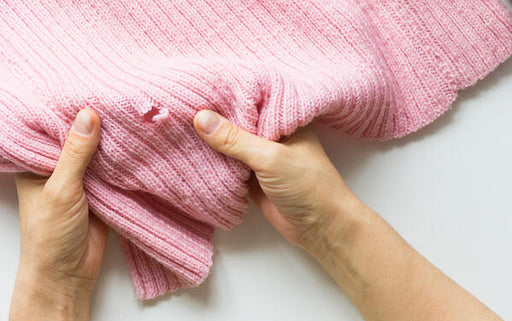Why Do Moths Eat Clothes?

That may seem like an obvious statement, but it is important to know that there are a wide variety of moths, and only a subset of those cause damage. Of those types of moths, the main split of groups are those which damage clothing, home textiles, carpets and rugs, and those that infest dried foodstuffs, commonly known as pantry moths.
These two broad groups above differ from the majority of moth species in that they both dislike light and look for dark, undisturbed places in your home.
And please remember that it is the moth larvae that cause the actual damage.
Do Moths Eat Clothes?
- Adult clothes moths do not eat clothes - it is their larvae that do the damage
- Animal-fiber based fabrics are targeted - think cashmere, wool, silk
- It is clothes moth larvae that do the damage, not adult clothes moths
- Clothes moth larvae get their sustenance from eating keratin, the protein in animal-based fibers
- Damage to clothes and other evidence will indicate a serious clothes moth infestation
- Clothes Moth Traps will reduce the population over time
- For a larger infestation you may like to read our Clothes Moth Kit Guide for information on how to use chemical products in line with our Traps to rid your home of Clothes Moths
- MothPrevention can guide you and provide the support you’ll need

Clothes Moths or Carpet Moths?
There is no distinction between the species of moth that may attack your clothes or carpets - these terms are commonly used depending on where the damage in your home has been found.
There are two main species most commonly found in the home; the webbing clothes moth (Tineola bisselliella) and the case-bearing moth (Tinea pellionella).
Two other species that main be found that target clothes and home textiles are the white-shouldered house moth and the brown house moth.
Lifecycle Stages
Adult clothes moths only live for around one month and their sole purpose is to mate and for the female clothes moth to lay eggs. They do not eat anything during that short life as an adult. The eggs hatch into larvae and it is the larvae that eat clothes. The larvae pupate and then turn into adult clothes moths, and so complete the lifecycle.
From the presence of adult clothes moths to the start of damage of your valuable possessions could be as little as 4 to 6 weeks!
Why do Moths Eat Clothes?
Or, given our understanding of the clothes moth life cycle, more specifically, why do moth larvae eat clothes?
The larvae need sustenance to enable them to grow and pupate into adult clothes moths. Clothes moths have evolved to get their sustenance from Keratin - this is the protein in animal-based fabrics (cashmere, wool, silk, feathers, fur mainly). This is why your investment pieces in your wardrobes, your precious home textiles and your valuable rugs and carpets are threatened by the presence of clothes moths.
Keratin is also in human hair and shed skin cells. Household dust contains human and pet hair / skin cells so cleanliness is important.
Putting this together, and considering our busy lifestyles, the following common scenarios show how our homes can easily create the perfect breeding ground for clothes moths:
- Under the sofa - heavy furniture is difficult to move, vacuuming is often a quick chore, and moths love darker undisturbed places to lay their eggs - furniture often sits on natural wool carpets or rugs.
- In the wardrobe in the spare bedroom - through the summer months, heavier winter clothing (sweaters and coats in particular) are often stored hung in wardrobe or folded in dresser drawers. They are not always stored in breathable, moth-proof garment storage bags, and often lay untouched for months on end.
- In the attic - so many times we have heard the stories of the silk Persian rug or grandma’s fur coat being (no longer PC to wear in public, yet a treasured possession passed down the family) stored in the attic. Often these items lay unmoved in the dark for years, and so creating the perfect environment for a really serious clothes moth infestation. It may be only time before the moths migrate to your wardrobe in search of the soft, tasty cashmere!

Do Moths Eat Other Fabrics?
Very occasionally we have customers who have found moth larvae damage to plant-based fabrics (the most common of which is cotton garments). How could that happen?
As gross as it sounds, we must not shirk from the facts! This would only happen when a cotton garment is heavily soiled with food stains or human perspiration.
Most times when a customer asks about the holes in their cotton t-shirts, it is from damage caused by using the washing machine (fabric catching on buttons, clips, fasteners etc) or rubbing against a belt buckle when worn.
How can you tell if you have or are soon going to have moth damage?
Moth eggs are so small and often fall deep into the weave of loosely woven / knitted fabrics that they are very difficult to spot. So, there are visual clues to tell if you have a problem with moths eating clothes and other home textiles:
Can you see any webbing (thin, translucent, like spun silk) or cases from clothes moths?

Can you see the larvae? Usually a quarter to half inch long, cream colored and a small brown head like little maggots (yes, we’re afraid so!)
Can you see holes or what look like small tears in garments that shouldn’t be there?
Can you also find carpet / rug piles eaten down and in the most extreme cases, you may see threadbare patches?
Have you seen adult clothes moths flying (or more likely resting in dark places)?
Ok, I’ve seen that moth larvae are eating my clothes; now what?
As specialists in dealing with clothes moth problems and having helped nearly 150,000 customers solve their moth problems, we can be your guide through this process.
Firstly, maintain active clothes moth traps to monitor for adult moth activity and reduce the population - remember that one mated female can lay 200 eggs in her very short life - it's easy to see how quickly it can get out of control.
Secondly, try to trace the original source of the infestation and especially check any attics or basements that are less-frequently used. Wipe everything down with a cleaning solution and vacuum thoroughly getting into cracks and crevices. Throw away infested items.
If the infestation is larger than anticipated, you may like to read our Clothes Moth Kit Guide, which gives you guidance about using chemical products in line with our Traps.

Further Resources
You may find it helpful to read further with our step by step guide on how to stop moths from eating clothes.
We also can help identify your specific moth species if you are unsure. Please see our clothes moth identification guide or email us a clear picture and we’ll help you out.
Learn more about wool moth traps, our powerful pheromone moth traps designed to help prevent clothes moths from eating your precious cashmere.
We have a separate blog post on how to get rid of pantry moths and Pantry Moth Traps if that's your concern.
Please remember that if you need any guidance on treatments, identification of Moths or anything else, we are here to help - Contact Us.
FAQs for Why Do Moths Eat Clothes - Here's What You Should Know
Ever wonder why moths eat clothes? In a nutshell, moth larvae eat clothes as a food source. Although adult moths do not eat clothes, they do lay eggs, which hatch into larvae. These larvae then burrow through natural fibers and leave destruction in their wake. The good news is that moth larvae don't eat all types of fabrics. Moreover, adult moths won't damage your clothes and can be prevented from entering your home.
Do moths chew holes in clothes?
No. Adult moths don’t eat clothes. However, an adult moth lays eggs that then hatch into moth larvae. Moth larvae consume natural fibers and animal products like fur, silk, wool, and feathers. Moth larvae can, and will, chew holes in your clothes as they derive key nutrients from these animal fibers.
How do you tell if moths are eating your clothes?
You can tell if moth larvae are eating your clothes because there will be evidence. The three main types of evidence are larval casings, dead moths or larvae, and tunnel-like holes in your natural fiber garments.
The larvae shed casings as they grow. The casings will usually be hollow, dry, tan or brown, and tube-shaped in appearance. You may also find dead larvae or dead adult moths nearby. If you see these signs, it’s time to take action.
How quickly do moths eat clothes?
Moth life cycles and habits depend entirely on the climate and environment of your area. Destruction can be fast or slow. Moth eggs hatch within 14 days but the larvae can then lay dormant due to colder temperatures meaning the destruction of your clothing comes at a slower pace. The bottom line is, if you notice signs of an infestation, eliminate it right away.
Do moths eat cotton shirts?
Yes, moth larvae can and will eat cotton but only if it is damp, or is showing evidence of food or sweat stains. As long as cotton shirts are clean and dry they should not be at risk. In general moth larvae prefer to feast on animal based fibres that contain keratin.
About MothPrevention
MothPrevention® speak to customers every day about their clothes moth issues - clothes moths are a species that are ever increasing and that can cause significant damage to clothes, carpets and other home textiles.
To date, we’ve helped over 250,000 customers deal with their moth problems. We have developed professional grade solutions including proprietary pheromones and trap design, not available from anybody else in the USA.





